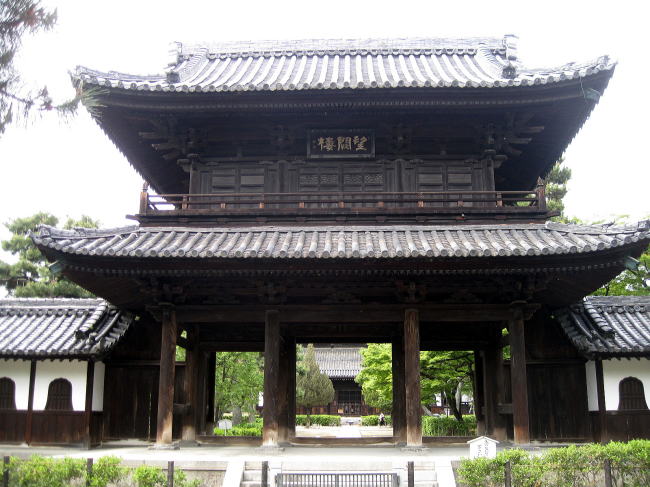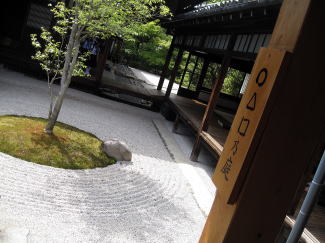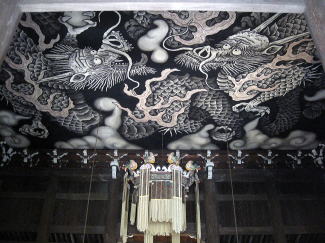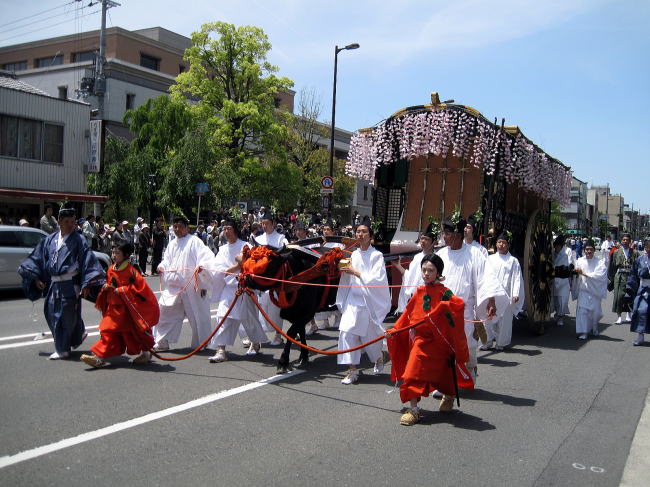Weekly Topics/Archive
May 2010
|
All the morning, I looked on Aoi Festival in Kyoto with my wife, my daughter
and her friend.
After that, I parted company with my wife who was scheduled to be at her class reunion
and then we had a lunch break at a Japanese restaurant in Imadegawa.
After lunch, I also parted company with my daughter and her friend and
then visited kennin-ji
temple near Gion as scheduled.
 |
| Kennin-ji's temple gate |
Kennin-ji is a temple of the Zen sect, one of the main branches of Japanese
Buddhism in
Higashiyama, Kyoto, near Gion.
At present, there are three branches of Zen in Japan−the Rinzai, Soto,
and Obaku schools.
Kennin-ji belongs to tr Rinzai scool.
The Rinzai school hase also fourteen branches.
Kennin-ji is the head temple of Kennin-ji branch, which is one of them.
Kennin-ji is the oldest Zen temple in Kyoto, which is one of Kyoto's so-called
Five Great Zen
Temples (the Kyoto Gozan).
I toured Kamakura's Five Great Zen Temples last year.
But they belonged to the kencho-ji or Engaku-ji school of the Rinzai sect
of Zen Buddhism.
In Kyoto, I've visited only Nanzen-ji temple, which is the head temple
presiding over
the Gozan in Kyoto.
And so I visited Kennin-ji and walked around the temple grounds taking
about tow hours this time.
Kennin-ji had much to offer visitors.
It featured Cho-on-tei Garden, ○△□ Garden, the national treasure "Fuun-Raizin-zu
Byobu", Fusuma painting by Kansetsu Hashimoto, the "Cloud Dragon"
by Kaiho Yusho, the "Twin Dragons" by Koizumi Junsaku and so
on.
 |
 |
| ○△□ Garden. |
The "Twin Dragons" by Koizumi Junsaku |
For details about "Visiting Kennin-ji",please visit the following
picture.
 Picture / Pilgrimage to old temples. / 「京都・古寺巡礼--東山 建仁寺--」 Picture / Pilgrimage to old temples. / 「京都・古寺巡礼--東山 建仁寺--」
Anyway, I thoroughly enjoyed soaking up history today.
[Note] part company with 〜 ; 〜と別れる、 have a lunch break with 〜 ; 〜と昼食休憩する
Zen sect ; 禅宗、 main branches of Japanese Buddhism ; 日本の主要仏教宗派
at present ; 今(現在)のところ、 school ; 流派,派、 Kyoto's Five Great Zen Temple ; 京都五山
tour ; 巡る、 Rinzai sect ; 臨済宗、 Engaku-ji school ; 円覚寺派
preside over 〜 ; 〜を統括する,主宰する、 the Gozan in Kyoto ; 京都五山、walk around ; 散策する
have much to offer visitors ; 参拝客にとつて見どころが多い、 feature 〜 ; 〜を呼び物にする
Cho-on-tei Garden ; 潮音庭、 Fusuma painting ; 襖絵、 Fuun-Raizin-zu Byobu ; 風雲雷神図屏風
soak up history ;歴史に浸る
Japanese Diary / No.265−2010.05.15 / 「京都・葵祭見物と建仁寺散策」 Diary / No.265−2010.05.15 / 「京都・葵祭見物と建仁寺散策」
My daughter who has worked in Bangkok,Thailand,has taken a long vacation since
the end of April and returned temporary to Japan.
I heard she was planning to look on Aoi Matsuri in Kyoto with her friend
from Vienna in
Austria on May 15,so I decided to join them.
My wife who came to the place in Kusatsu yesterday to attend her high school class reuion
in Kyoto was also with us.
I looked on Aoi Matsuri only once when I was a child,so I have only a fuzzy
recollection
of it.
But my recollection is not as clear as I can reproduce the festival's scene
on my brain.
As the proverb says, "One must go abroad to hear of home."
And so, I decided to go to the festival because it was also a good day for going
out for a holiday.
Aoi Matsuri is an annual festival which is hold by Kamigamo and Shimogamo shrines
on May 15.
It is now one of the Kyoto's three big festivals (Aoi,Gion,Jidai) and
also one of the most
solemn and graceful festivals in Japan.
It is named after aoi leaves,which are used to decorate the costumes of
the participants.
 |
The saio−dai procession as the highlight of the festival
The saio−dai is a young women (in the Heian period, she was always an
imperial princess) who rides on a palanquin carried on men's shoulders.
She is followed by suites,warriors,court ladies and so on.
The participants in Saio−dai procession are decorated with cherries and
leaves of oranges added to the hollyhock leaves.
|
The highlight of the festival is the procession called “Roto-no-gi”.
It's said the procession consists of 511 people, 36 horses, 4 cows and 2 carriages, and
runs about 1 kilometer from the front to the back.
The procession starts at Kyoto Gosho and goes through Shimogamo shrine
to Kamigamo
shrine.
Participants march along the street, wearing colorful and traditional
costumes which revive
the noble court life in Heian Period and putting aoi leaves on their dresses
and even on their
heads.
Some of them march with a carriage called "Gissha" well−known
as "Gosyo−Guruma".
It is pulled by an ox decorated in full and goes very slowly,giving squeaking
sounds.
 |
Gissha
This is a carriage well−known as "Gosho−Guruma". Since the Heian
Period,this was used for the transportation of Emperors and courtiers of
high rank. |
We came to Sakaimachi Gate of the Kyoto Imperial Place facing Marutamachi street around
10 a.m,where is the starting point of the procession, and then secured a spot near there for
looking on it.
I just felt as if I was looking at a picture scroll about graceful procession
in the court of
the Heian period.
For details about Aoi Matsuri,please visit the following picture.
 Picture / The Others / 「京都・葵祭」 Picture / The Others / 「京都・葵祭」
[Note] return temporarily to Japan ; 日本へ一時帰国する、 look on ; 見物する
Vienna ; ウィ−ン、 have only a fuzzy recollection of 〜 ; 〜について曖昧にしか記憶していない
One mast go abroad to hear of home. ; 灯台下暗し、 go out for a holiday ; 行楽に出掛ける、
annual festival ; 例祭、 solemn ; 厳粛な、 graceful ; 優雅な、 aoi leaves ; 葵の葉
procession ;行列、 Roto-no-gi ; 路頭の儀、 saio−dai ; 斎王代、 imperial princess ; 皇女
palanquin ; (一人乗りの) かご、 suite ; 随行員、従者、 warrior ; 武官
hollyhock leaves ; タチアオイ(植物)の葉、 revive 〜 ; 〜(物・事)をよみがえらせる、 noble ; 貴族の
court life ; 宮廷生活、 Heian period ; 平安時代、 Gissha ; 牛車(ぎっしゃ)
Gosyo−Guruma ; 御所車、 squeaking sound ; 軋んだ音,キ−キ−という音
courtier ; 宮廷の役人、廷臣、 Kyoto Imperial Place ; 京都御所、 picture scroll ; 絵巻物
secure a spot for 〜 ; 〜のための場所を確保する
Japanese Diary / No.265−2010.05.15 / 「京都・葵祭見物と建仁寺散策」 Diary / No.265−2010.05.15 / 「京都・葵祭見物と建仁寺散策」
 TOPペ−ジへ戻る TOPペ−ジへ戻る
|